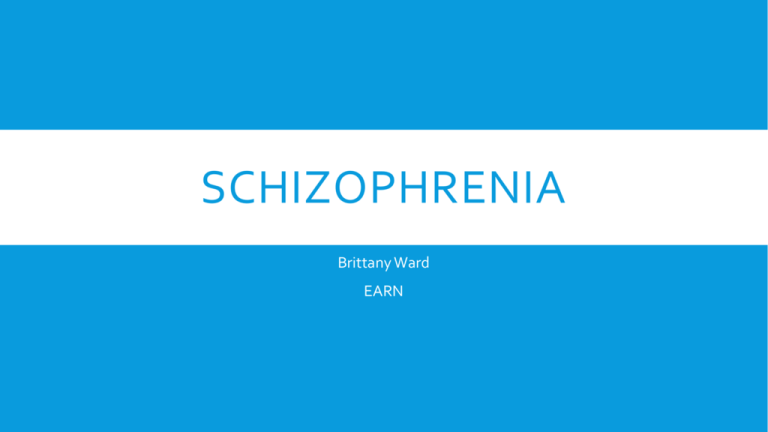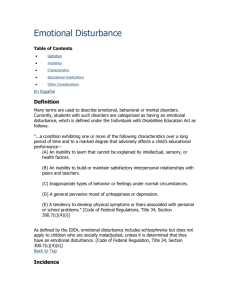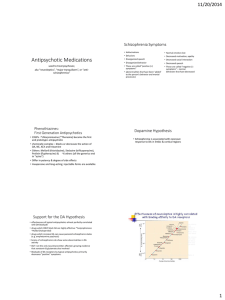Student LEarning Activity
advertisement

SCHIZOPHRENIA Brittany Ward EARN DEFINITION Psychiatric disorder characterized by thought disturbance, altered affect, withdrawal from reality, regressive behavior, difficulty with communication, and impaired interpersonal relationships. Five types 1) Catatonic- stupor, rigidity, posturing, and excitement 2) Disorganized- incoherence, flat or inappropriate affect 3) Paranoid-delusions, hallucinations related to a single theme or both 4) Residual- socially withdrawn, eccentric or peculiar behavior, no current psychotic behavior 5)Undifferentiated- prominent delusions and hallucinations, failure to meet any of the criteria for the other types PATHOPHYSIOLOGY The cause has not been determined but several theories have been proposed. Genetic component Imbalance in neurotransmitters in certain brain areas Overactive dopamine receptors in the basal nuclei. The area of the brain that controls motor activity PSYCHOSES Signs and symptoms are often associated with other mental health problems including substance abuse, depression , and dementia. Approximately 3 million Americans have schizophrenia (Adams & Holland 2014). Patients with psychosis often develop symptoms between the age of 13 and the early 20s. As much 50% of homeless people in America have schizophrenia (Adams & Holland 2014). NURSING ASSESSMENT Asses for disturbance in thought process. Interpret content of internal and external stimuli. Delusions- fixed false beliefs that may be persecutory, grandiose, religious, or somatic Ideas of reference- belief that conversations or actions of others have reference to the client Assess for disturbance in perception Assess for disturbance in affect and behavior Assess for disturbance in interpersonal relationships MANIFESTATIONS Looseness of associations Echolalia- constantly repeating what is heard Neologism- creating new words Word salad- speaking a jumbled mixture of real and made-up words Hallucinations- false sensory perception usually auditory or visual in nature Illusions- misinterpretation of external environment Depersonalization- perceives self as alienated or detached from real body Delusions- false fixed beliefs that cannot be changed by reason DIAGNOSIS DSM-IV-TR, diagnostic manual prepared by the American Psychiatric Association that provides diagnostic criteria for all disorders NURSE INTERVENTIONS Establish trust Sit with mute clients Provide safe and secure environment Use matter- of- fact, no judgmental approach Use simple, clear, concrete terms when talking with client Use clarification Avoid arguing and avoid agreeing with inaccurate communications Encourage client to identify positive characteristics related to self PHARMACOLOGY TREATMENT- DRUGS Conventional Antipsychotics Chlorpromazine Fluphenazine Perphenazine Compazine Atypical antipsychotics Haldol Abilify Seroquel Geodon DRUG SIDE EFFECTS Headache Dizziness GI symptoms- nausea and constipation Thrombocytopenia Photosensitivity Serotonin Syndrome Anti-Cholinergic effects Severe Extrapyramidal effects EXTRAPYRAMIDAL EFFECTS Parkinsonism-Rigidity, shuffling gait, pill rolling hand movements and mask like face Akathisia- restlessness, agitation, and pacing. Sudden difficulty sitting down. Dystonia- limb ad neck spasms, uncoordinated, jerky movements, difficulty speaking and swallowing, rigidity and muscle spasms. Tardive dyskinesia (permanent side effect)- Involuntary tongue and lip movements, blinking, tonic movements of limbs and trunk Treatment of EPS- anticholinergic drugs (Cogentin, Artane, Benadryl, Ativan, and Klonopin) EVIDENCE-BASED TREATMENT Milieu therapy Behavior Modification Family therapy Crisis intervention Cognitive therapy Electroconvulsive Therapy Group Intervention Drugs YOUTUBE http://youtu.be/WjqRYgICgdU http://youtu.be/bWaFqw8XnpA REFERENCES Adams, M.P., & Holland, L.N. (2014). Pharmacology for nurses: A pathophysiology approach (4th Edition). Elsevier.( 2011). HESI Comprehensive review for the NCLEX-RN Examination. (3rd Edition).







